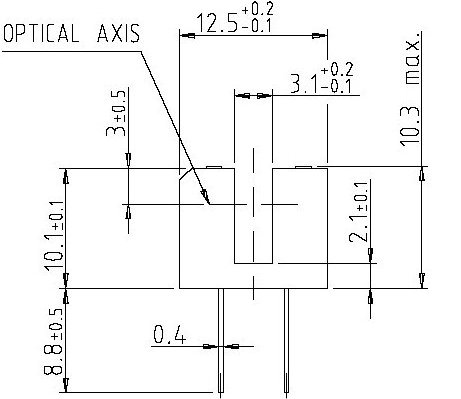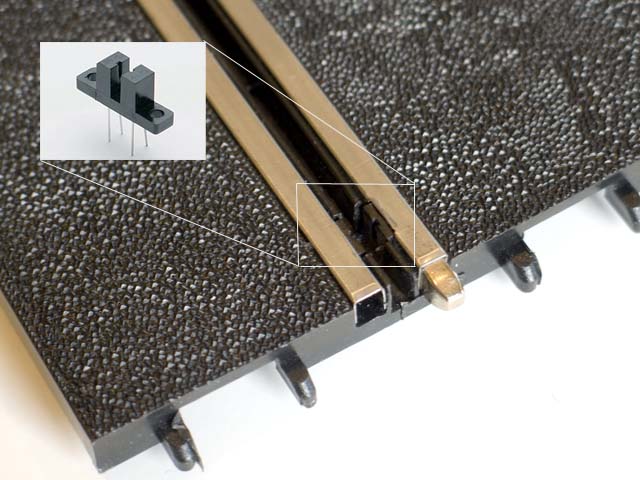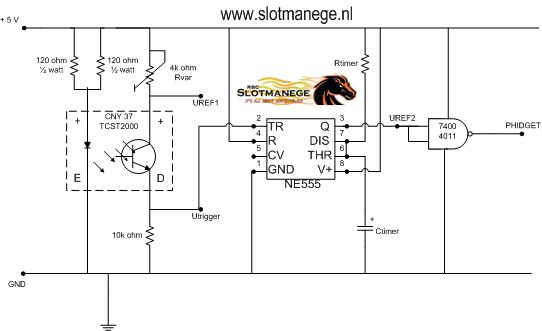Posted by Slotmanege:
As promised I would post our used hardware scheme here.
We have been struggling with our hardware for some time now. And it seems to be working at last (no more missed laps). But to be 100% sure we have to do some more testing and do some final adjustments. Things we have to do (final adjustments) = making use of shielded data-cables. Because of many electro magnetic influences (power cables and electro motors) it is best to shield the the data lines.
We make use of the Phidget 8/8/8. And for lap counting we use the digital inputs because they are 'faster' then the analog inputs.
Below you can see the slot-mounted IR-sensors (CNY37 = TCST2000) which we are using on our track.
Using these sensors you don't need a separate light-source above the sensors because the sensors actually have their own sender and receiver unit.



Anyway... Here is the electrical scheme:

I will try to explain it here:
In 'idle' state... so no slotcars racing on the track the IR sensor actually act as a closed switch. This means that the voltage on label UREF1 is about 3,6 volts. The Rvar is a potentiometer (variable resistor). The 'best' value to set the Rvar is around 4k. It is wise to install a Rvar with a larger value then 4k (minimal value = 5k). In this way you can 'fine-tune' the Rvar to get the desired 3,6 volts on label UREF1. When using a non variable, fixed resistor for Rvar it is best to keep it on 4k.
In idle state the rest of the electronics are also idle and the output (label PHIDGET) voltage is = +5 Volts.
Whenever a guidance-flag of a slotcar passes the sensor the IR light-beam is interrupted and the sensor acts as a closed switch (for as long as the beam is interrupted). This causes a voltage drop on label Utrigger from 3,6 volts down to 0 volts.
The NE555 (timer IC) reacts on this voltage drop (NE555 reacts whenever the voltage drops more then 2/3 of V+) and starts the timer. The timer is used to extend the length of the pulse, long enough that the Phidget 8/8/8 can read it correctly. The length of the pulse = interval time (t) is given by: t = 1.1 x Rtimer x Ctimer. (C is a electrolytic capacitor). This means that the voltage on label UREF2 is +5 Volts (during the interval time).
The last part of the diagram shows a logical gate. We make use of the 4011 CMOS NAND gate (but a TTL NAND gate from the 7400 family should also do the trick). The NAND gate converts the +5 Volts from label UREF2 towards the 0 volts (label PHIDGET) which is needed to trigger the Phidget 8/8/8 digital input.
If you want to use this diagram with the Phidget 0/16/16 you easily replace the NAND with an AND logical gate.
More info about NE555 timer = http://en.wikipedia.org/wiki/555_timer_IC
More info about 7400 logical gates = http://en.wikipedia.org/wiki/7400_series
More info about 4000 logical gates = http://en.wikipedia.org/wiki/4000_series
The only flaw of the used sensors is that these sensors do not recognize blue and white guidance-flags. Only black ones !!!
And we did remove some of the top of the sensors so the 'optical axis' becomes closer to the track.
If you have questions or remarks, please ask !
We are also very interrested in your opinions about our hardware? Perhaps we still can improve!
Regards,
Danny
http://www.slotmanege.nl (sorry... only in Dutch)
